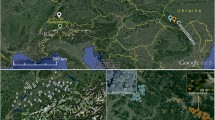Abstract
Variable-number-of-tandem-repeats (VNTR) markers are increasingly being used in population genetic studies of bacteria. They were recently developed for Pasteuria ramosa, an endobacterium that infects Daphnia species. In the present study, we genotyped P. ramosa in 18 infected hosts from the United Kingdom, Belgium, and two lakes in the United States using seven VNTR markers. Two Daphnia species were collected: D. magna and D. dentifera. Six loci showed length polymorphism, with as many as five alleles identified for a single locus. Similarity coefficient calculations showed that the extent of genetic variation between pairs of isolates within populations differed according to the population, but it was always less than the genetic distances among populations. Analysis of the genetic distances performed using principal component analysis revealed strong clustering by location of origin, but not by host Daphnia species. Our study demonstrated that the VNTR markers available for P. ramosa are informative in revealing genetic differences within and among populations and may therefore become an important tool for providing detailed analysis of population genetics and epidemiology.

Similar content being viewed by others
References
Bois PR (2003) Hypermutable minisatellites, a human affair? Genomics 81:349–355
Bzymek M, Lovett ST (2001) Instability of repetitive DNA sequences: The role of replication in multiple mechanisms. Proc Natl Acad Sci U S A 98:8319–8325
Carius HJ, Little T, Ebert D (2001) Genetic variation in a host-parasite association: Potential for coevolution and frequency-dependent selection. Evolution 55:1146–1152
Colbourne JK, Robison B, Bogart K, Lynch M (2004) Five hundred and twenty-eight microsatellite markers for ecological genomic investigations using Daphnia. Mol Ecol Notes 3:485–490
Davies KG, Redden M (1997) Diversity and partial characterization of putative virulence determinants in Pasteuria penetrans, the hyperparasitic bacterium of root-knot nematodes (Meloidogyne spp.). J Appl Microbiol 83:227–235
Decaestecker E, Declerck S, De Meester L, Ebert D (2005) Ecological implications of parasites in natural Daphnia populations. Oecologia 144:382–390
Decaestecker E, Lefever C, De Meester L, Ebert D (2004) Haunted by the past: Evidence for dormant stage banks of microparasites and epibionts of Daphnia. Limnol Oceanogr 49:1355–1364
Decaestecker E, Vergote A, Ebert D, De Meester L (2003) Evidence for strong host-clone-parasite interactions in the Daphnia microparasite system. Evolution 57:784–792
Duncan AB, Mitchell SE, Little TJ (2006) Parasite-mediated selection and the role of sex and diapause in Daphnia. J Evol Biol 19:1183–1189
Ebert D (2005) Ecology, epidemiology, and evolution of parasitism in Daphnia. Bethesda, MD: National Library of Medicine, National Center for Biotechnology Information. Available from: http://www.ncbi.nlm.nih.gov/entrez/query.fcgi?db=books. Accessed:
Ebert D, Carius H-J, Little TJ, Decaestecker E (2004) The evolution of virulence when parasites cause host castration and gigantism. Am Nat 164(Suppl.):S19–S32
Ebert D, Rainey P, Embley TM, Scholz D (1996) Development, life cycle, ultrastructure and phylogenetic position of Pasteuria ramosa Metchnikoff 1888: Rediscovery of an obligate endoparasite of Daphnia magna Straus. Phil Trans Royal Soc London B 351:1689–1701
Ebert D, Zshokke-Rohringer CD, Carius HJ (1998) Within- and between-population variation for resistance of Daphnia magna to the bacterial endoparasites Pasteuria ramosa. Proc R Soc Lond B Biol Sci 265:2127–2134
Haldane JBS (1949) Disease and evolution. Ric Sci 19:2–11
Hamilton WD (1980) Sex versus non-sex versus parasite. Oikos 35:282–290
Keim P, Price LB, Klevytska AM, Smith KL, Schupp JM, Okinaka R et al (2000) Multiple-locus variable-number tandem repeat analysis reveals genetic relationships within Bacillus anthracis. J Bacteriol 182:2928–2936
Klevytska AM, Brice LB, Schupp JM, Worsham PL, Wong J, Keim P (2001) Identification and characterization of variable-number of tandem repeats in the Yersinia pestis genome. J Clin Microbiol 39:3179–3185
Kosman E, Leonard KJ (2005) Similarity coefficients for molecular markers in studies of genetic relationships between individuals for haploid, diploid, and polyploid species. Mol Ecol 14:415–424
Liao J-C, Li C-C, Chiou C-S (2006) Use of multilocus variable-number tandem repeat analysis method for molecular subtyping and phylogenetic analysis Neisseria meningitides isolates. BMC Microbiol 6:44
Lindstedt B-A (2005) Multiple-locus variable number tandem repeats analysis for genetic fingerprinting of pathogenic bacteria. Electrophoresis 26:2567–2582
Maiden MC, Bygraves JA, Feil E, Morelli G, Russel JE, Urwin R et al (1998) Multilocus sequence typing: A portable approach to the identification of clones within populations of pathogenic microorganisms. Proc Natl Acad Sci U S A 95:3140–3145
Mouton L, Nong G, Preston J, Ebert D (2007) Identification and characterization of variable number tandem repeats in an obligate endoparasite of Daphnia species. Appl Environ Microbiol 73:3715–3718
Nei M, Li WH (1979) Mathematical model for studying genetic variation in terms of restriction endonucleasis. Proc Natl Acad Sci U S A 76:5269–5273
Preston JF, Maruniak JE, Nong G, Brito JA, Schmidt LM, Giblin-Davis RM (2003) Pasteuria spp.: Systematics and phylogeny of these bacterial parasites of phytopathogenic nematodes. J Nematol 35:198–207
Sneath PA, Sokal RR (1973) Numerical taxonomy. Freeman, San Francisco, CA
Top J, Schouh LM, Bonten MJ, Willems RJ (2004) Multilocus variable number of tandem repeats analysis, a novel typing scheme to study the genetic relatedness and epidemiology of Enterococcus faecium isolates. J Clin Microbiol 42:4503–4511
van Belkum A, Scherer S, van Alphen L, Verbrugh H (1998) Short-sequence DNA repeats in prokaryotic genomes. Microbiol Mol Biol Rev 62:275–293
Acknowledgments
We thank I. Colson and L. Du Pasquier for useful discussion and comments, B. Aeschbach for technical help, and T. Little, E. Decaestecker, and S. Hall for providing samples. S. Zweizig and I. Colson improved the English language of the manuscript. This work was supported by grants from the Swiss Nationalfonds and the Freiwillige Akademische Geselschaft, Basel, Switzerland.
Author information
Authors and Affiliations
Corresponding author
Rights and permissions
About this article
Cite this article
Mouton, L., Ebert, D. Variable-Number-of-Tandem-Repeats Analysis of Genetic Diversity in Pasteuria ramosa . Curr Microbiol 56, 447–452 (2008). https://doi.org/10.1007/s00284-008-9104-1
Received:
Accepted:
Published:
Issue Date:
DOI: https://doi.org/10.1007/s00284-008-9104-1




